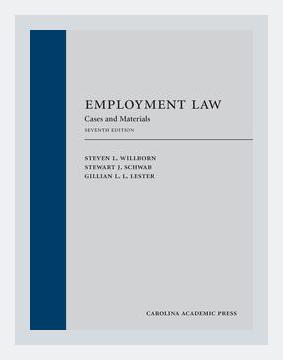Business Law and EthicsEmployment Law
I. Introduction to Employment Law
Overview:
This textbook covers the intricate landscape of employment law, focusing on U.S. regulations and case laws. It provides a comprehensive analysis of key statutes, judicial decisions, and administrative actions that shape employment relationships.
Key Point:
– Definition and Scope:
Employment law encompasses both statutory protections, like the Fair Labor Standards Act (FLSA), and common-law doctrines governing agreements between employers and employees.
Action Point:
– Staying Informed:
Regularly read legal updates and case law summaries to stay informed about changes and developments in employment law.
II. Employment Relationship
Overview:
The book begins with a foundational chapter that outlines the employment relationship, distinguishing between employees and independent contractors.
Example:
– Case Study: Dynamex Operations West, Inc. v. Superior Court of Los Angeles introduced a new test for determining independent contractor status, emphasizing control over work details.
Action Point:
– Classification Audit:
Conduct periodic audits of your workforce to ensure correct classification and avoid liabilities related to misclassification.
III. Employment Contracts
Overview:
This section delves into the nature of employment contracts, including express and implied terms and the enforceability of contractual obligations.
Example:
– Case: Glatt v. Fox Searchlight Pictures discussed the importance of clear contract terms when bringing on interns or freelancers, to prevent disputes regarding compensation.
Action Point:
– Drafting Clear Contracts:
Ensure all employment contracts clearly outline terms of employment, compensation, job duties, and termination conditions.
IV. Wrongful Termination
Overview:
Explores wrongful termination doctrines, including violations of public policy, implied contracts, and tort claims.
Example:
– Case: Beach v. Owens-Corning Fiberglas Corp. highlighted the implications of the implied covenant of good faith and fair dealing in wrongful termination suits.
Action Point:
– Employee Handbooks:
Regularly update employee handbooks to reflect current legal standards and clearly articulate policies on termination.
V. Wage and Hour Laws
Overview:
Analyzes federal and state wage and hour laws, including minimum wage, overtime pay, and exemptions under the FLSA.
Example:
– Case: Barrentine v. Arkansas-Best Freight System, Inc. underscored the necessity for employers to meticulously record hours worked to ensure compliance with FLSA requirements.
Action Point:
– Accurate Record-Keeping:
Implement robust time-tracking systems to ensure accurate recording of work hours and proper payment of wages.
VI. Anti-Discrimination Laws
Overview:
Discusses various anti-discrimination statutes, such as Title VII, the Americans with Disabilities Act (ADA), and the Age Discrimination in Employment Act (ADEA).
Example:
– Case: Griggs v. Duke Power Co. set a precedent for disparate impact claims, clarifying that employment practices that are non-discriminatory in intent but discriminatory in outcome are prohibited.
Action Point:
– Diversity Training:
Conduct regular diversity and inclusion training to educate employees about anti-discrimination policies and practices.
VII. Harassment in the Workplace
Overview:
Addresses laws and regulations pertaining to workplace harassment, including sexual harassment and hostile work environments.
Example:
– Case: Meritor Savings Bank v. Vinson established the standards for proving a hostile work environment under Title VII.
Action Point:
– Zero Tolerance Policy:
Implement and enforce a zero-tolerance policy for harassment, include procedures for reporting and handling complaints.
VIII. Employee Privacy
Overview:
Explores privacy rights of employees in the workplace, including monitoring, drug testing, and access to personal information.
Example:
– Case: O’Connor v. Ortega highlighted issues surrounding the balance between employee privacy rights and employer’s business interests, particularly in searches of employee property.
Action Point:
– Transparent Policies:
Develop and communicate clear policies on workplace monitoring and searches, ensuring they adhere to legal standards and respect privacy rights.
IX. Occupational Safety and Health
Overview:
Examines the Occupational Safety and Health Act (OSHA) and employers’ obligations to provide a safe working environment.
Example:
– Case: Marshall v. Barlow’s, Inc. emphasized employers’ obligation to comply with OSHA inspections, even if they object to certain regulatory measures.
Action Point:
– Regular Safety Audits:
Schedule regular safety audits and training to maintain compliance with OSHA standards and ensure a safe working environment.
X. Employee Benefits and Compensation
Overview:
Discusses laws related to employee benefits, including the Employee Retirement Income Security Act (ERISA), healthcare plans, and other compensation-related issues.
Example:
– Case: Firestone Tire & Rubber Co. v. Bruch clarified the standard of review for denial of benefits under ERISA, critically impacting how benefit claims are handled by employers.
Action Point:
– Benefit Plan Reviews:
Periodically review and update employer-sponsored benefit plans to ensure compliance with ERISA and other applicable laws.
XI. Collective Bargaining and Labor Relations
Overview:
Covers the National Labor Relations Act (NLRA), emphasizing employees’ rights to organize, unionize, and engage in collective bargaining.
Example:
– Case: National Labor Relations Board v. Jones & Laughlin Steel Corp. reaffirmed the right of employees to unionize and engage in collective bargaining without employer interference.
Action Point:
– Union Communication:
Foster transparent communication between management and union representatives to ensure smooth labor relations and resolve conflicts amicably.
Conclusion
“Employment Law: Cases and Materials” by Steven L. Willborn provides a detailed and multifaceted overview of employment law, combining theoretical insights with practical examples and case studies. The book serves as an essential guide for employers, HR professionals, and legal practitioners to navigate the complexities of employment law effectively.
Action Summary:
- Stay informed on legal updates.
- Conduct classification audits.
- Draft clear, precise employment contracts.
- Regularly update employee handbooks.
- Implement accurate time-tracking systems.
- Conduct diversity and inclusion training.
- Enforce zero-tolerance policies for harassment.
- Develop transparent privacy and monitoring policies.
- Schedule regular safety audits.
- Review and update employee benefit plans.
- Foster communication with union representatives.
In incorporating these strategies, individuals and organizations can better manage legal risks, promote fair and compliant workplace practices, and foster a positive employment environment.
